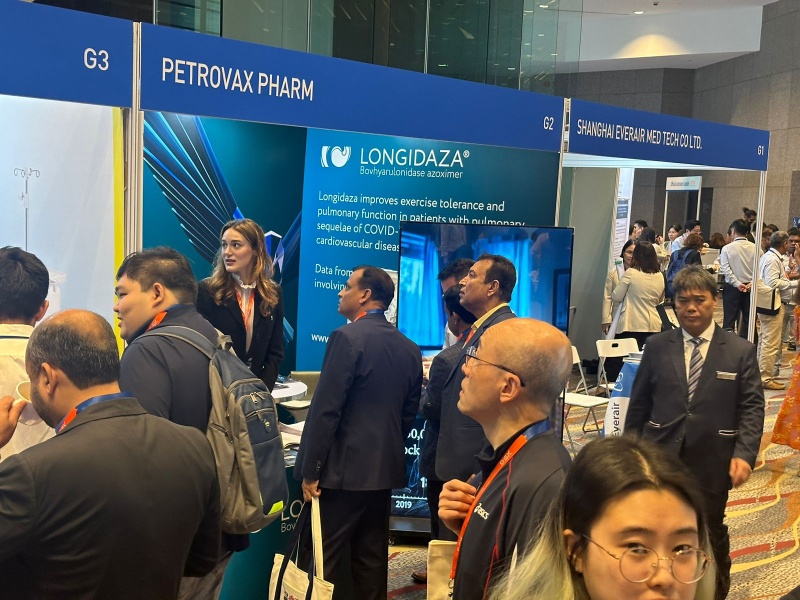
Original drug Longidaza® presented in China

The results of a study on Longidaza® for the treatment of COVID-19 complications were presented by Sergei Avdeev, Chief Federal Specialist in Pulmonology of the Russian Ministry of Health, at the 28th APSR Congress in Hong Kong. This congress is the largest forum on respiratory medicine in the Asia-Pacific region. The therapy with this unique Russian molecule helps reduce dyspnea, increases forced vital capacity of the lungs, and improves exercise tolerance[1].
According to the World Health Organization, 10–20% of people who have recovered from COVID-19 suffer from so-called "Long COVID", a condition characterized by symptoms that persist after the acute phase of the disease has passed. This affects the quality of life of at least 65 million people worldwide, with the actual number likely being higher[2].
The consequences of COVID-19 can persist for 6, 12, or even 24 months after recovery, leading to ongoing health problems and a reduced quality of life[3]. Among the most common issues are heart-related disturbances, weakness, and rapid fatigue. Another prevalent issue is lung damage, such as fibrotic changes.
Longidaza® (Bovhyaluronidase Azoximer), a drug containing conjugated hyaluronidase, breaks down excess hyaluronic acid, which can increase inflammation and lead to pulmonary fibrosis. The effectiveness of this drug in combating the consequences of COVID-19 was evaluated in a double-blind, placebo-controlled study involving 392 patients who had contracted COVID-19 3–12 months before the study began.
The study found that Longidaza therapy significantly improved the condition of patients with residual lung damage following COVID-19, particularly in the most vulnerable groups: the elderly, women, and patients with cardiovascular diseases.
By day 71, bovhyaluronidase azoximer therapy resulted in a significant reduction in the proportion of patients experiencing dyspnea and desaturation during exercise. By day 180, there was a significant increase in forced vital capacity in the groups of patients with cardiovascular diseases and patients over 60 years of age who received bovhyaluronidase azoximer, compared with those in the placebo group. The drug is well tolerated and has a favorable safety profile.
The results obtained indicate the potential of using bovhyaluronidase azoximer to address the respiratory consequences of COVID-19 infection. While further studies are ongoing, the data already available demonstrate its benefits for patients[4].
1Avdeev, Sergey & Ignatova, Galina & Drapkina, Oxana & Popova, Veronika & Melnikova, Ekaterina & Chudinovskikh, Tatiana & Ryabova, Olga & Egorova, Natalia & Rubanik, Tamara & Shvarts, Yury & Polyakova, Svetlana & Dzutseva, Vitalina & Antonova, Anna & Zubkov, Dmitry & Khmelevskii, Mikhail & Khomyakova, Nadezhda & Tsyferov, Mikhail & Hardman, Tim & Tikhonov, Anton. (2024). Bovhyaluronidase azoximer for long-term pulmonary sequelae of COVID-19: a randomized, double-blind, placebo-controlled trial. 10.1101/2024.09.19.24313792.
2Davis HE, McCorkell L, Vogel JM, Topol EJ. Long COVID: major findings, mechanisms and recommendations. Nat Rev Microbiol. 2023 Mar;21(3):133-146. doi: 10.1038/s41579-022-00846-2. Epub 2023 Jan 13. Erratum in: Nat Rev Microbiol. 2023 Jun;21(6):408. doi: 10.1038/s41579-023-00896-0. PMID: 36639608; PMCID: PMC9839201.
3Hellman U, Rosendal E, Lehrstrand J, Henriksson J, Björsell T, Wennemo A, Hahn M, Österberg B, Dorofte L, Nilsson E, Forsell MNE, Smed-Sörensen A, Lange A, Karlsson MG, Ahlm C, Blomberg A, Cajander S, Ahlgren U, Lind A, Normark J, Överby AK, Lenman A. 2024. SARS-CoV-2 infection induces hyaluronan production in vitro and hyaluronan levels in COVID-19 patients relate to morbidity and long-term lung impairment: a prospective cohort study. mBio 15:e01303-24.
4https://www.medrxiv.org/content/10.1101/2024.09.19.24313792v1


